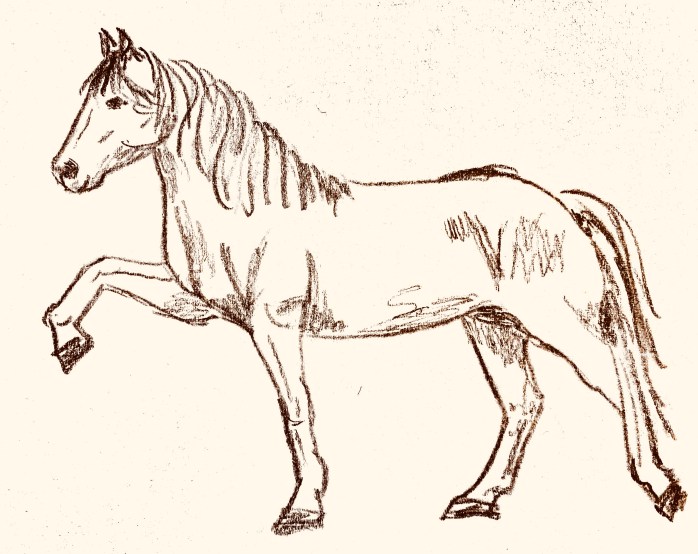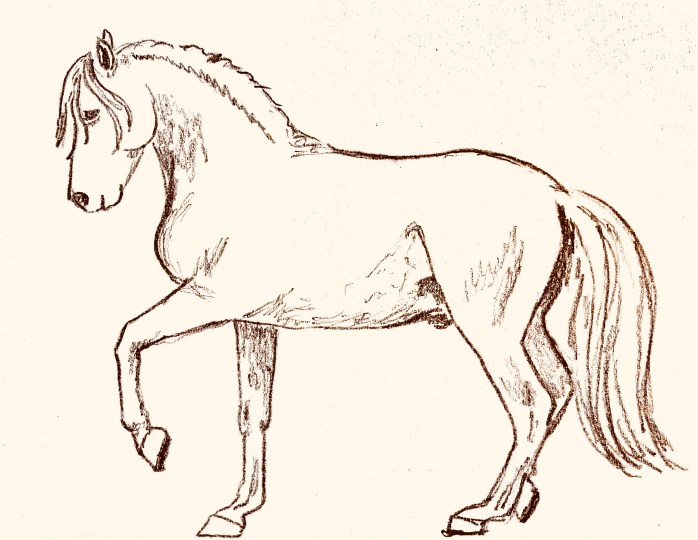Bee and the Horse
The Academic Art of Riding Blog from Poland
Just because we can, does it mean we should?

We all know that we can teach horses all kinds of things. Personally, when I teach something to my horses, I ask myself why I teach it and what it can be useful for.
As a simple example, let’s take a hindquarter disengage. I see a lot of students who taught their horses to stop on the longe this way. While I certainly want to be able to send the horse’s hindquarters away from me when needed (which is something I don’t need very often or not at all), I certainly don’t want my horses to stop via a hindquarter disengage as a habit. Why? Because it’s not really useful for anything other than stopping, and there are much better ways to stop, which can be built upon for further education.
If I want to longe my horses in walk, trot, and canter on the longe, I take care, already on a basic level, that the horses are well balanced and straight. A hindquarter disengage throws out the engine, so to speak, and brings the horse on the shoulder. Thus, I actually made it more difficult for the horse to start moving again and I brought him out of balance. There is nothing wrong with being able to have a hind quarter disengage in your tool box should you ever need it, like stopping a totally out of control horse. But practicing it on a regular, even daily basis has little benefit for the horse and furthermore, you teach your horse to stop on the front legs, which can also lead to overstrain and injury.

From a nicely balanced stop, however, I can ask easy transitions to trot and canter, and I can also start working towards bending the haunches in the standstill (which we call a school halt). When the horse swings out the hind quarter, I cannot put a halt on the hind legs or make easy transitions from, let’s say, canter to halt, school halt, canter. Teaching a balanced stop also helps horses in their daily life, because it’s always good when they stop less on the front legs (risk of injury) and use the hind legs more.
Or let’s have a look at Spanish walk. Personally, I don’t see a lot of Spanish walk from which the horse has benefit. Rather, the hind legs often step short and the back starts hanging a bit. Which is the opposite of what I would like to teach my horses. Some people say Spanish walk is good to get more shoulder freedom. But how much the horse can lift the front leg is actually not an indicator of shoulder freedom – it’s what the front leg which is still on the ground does. The more it pushes under the body mass, the more the horse is on the shoulder, even if the front leg is lifted and it looks spectacular.
On the other hand, when we teach the horse to bend the haunches and to lift his chest, the shoulder and front legs will lift naturally as well. It will not be an active lift but it will happen because the movement of the pelvis and spine transfer through the whole body. In that way, shoulder-freedom or lack thereof is a direct result of what happens in behind. An over-activation of the front leg, however, blocks the swinging of the spine. For that reason, I never touch front legs, neither in walk or trot (to get some kind of fake passage), and I also don’t activated the hind legs more than the chest can lift naturally.


While I do think it’s possible to teach horses a well-balanced Spanish walk, and it certainly looks nice on pictures, I have no use for it because I’m rather going for the school walk, in which the front leg lift comes from the hindquarter and pelvis activity. I have also seen a lot of horses who will start a Spanish walk when they don’t know what you want from them, and it can be quite difficult to get rid of that habit again because it’s a behaviour which horses use to impress other horses, so they generally love showing it.
Another exercise I don’t teach is rearing on command. My horses can all rear perfectly, I see it all the time. When horses rear, they straighten the hind legs and lift the front up in the air. My goal, however, is the bending of the haunches, so that they can better lift the chest (and me on top of this chest). So I’m much more interested in developing the levade, in which the horse lowers in behind instead of rising in the front. I don’t think it’s harmful for the horses to learn how to rear and some have a lot of fun with it. It certainly makes for lots of clicks on social media and looks impressive. But lots of clicks is not really what I’m interested in. I have never needed a horse to rear for any reason, so I don’t teach it.


Thus, when my students ask me about this or that exercise, or thing, which you can teach to the horses, my answer is mostly “I never saw the need to teach that because I have no use for it”. If I were a show trainer, on the other hand, I might think differently about that and I would teach my horses a lot more “tricks”.
If you enjoy trick training, that’s great, and the most important thing is that you and your horses have fun together. For many riders, teaching tricks is a great way to start with positive reinforcement, because we have a clear picture in mind and it’s often easy to break down tricks into little steps which can be rewarded. But it makes sense to stop and think for a moment what you would like to teach your horse, and why you would like to teach it. “Because everyone does it” or because it’s part of your program, might not be a good enough reason and sometimes we can even teach our horses something which turned out to be a nuisance and it will take us years to correct it. I still remember seeing one student at Bent’s who taught her horse to rear and that it took a long time to teach this horse the levade, because the horse didn’t understand why something he did for years was suddenly not what the human wanted.

It is actually a lot more difficult to un-teach a horse to do something than to teach something. So next time when you are something on social media or in a video, or in a book, and you want to teach it to your horse, pause for a moment and think about why you should teach it. Just because we CAN teach something to our horses, doesn’t mean we SHOULD.

Great article once again, Bettina. Awesome!